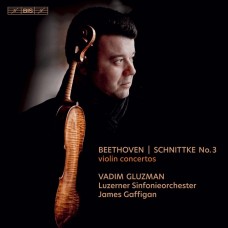貝多芬/施尼特凱: 小提琴協奏曲 瓦丁.葛魯茲曼 小提琴 加菲根 指揮 琉森交響樂團 Vadim Gluzman / Beethoven & Schnittke: Violin Concertos
|
貝多芬/施尼特凱: 小提琴協奏曲
在出版了幾張備受好評的布拉姆斯/布魯赫/柴可夫斯基偉大的浪漫小提琴協奏曲錄音專輯之後, 小提琴家瓦丁.葛魯茲曼接下一個在十九世紀初為此音樂類別規劃出一條新路徑的工作: 貝多芬的D大調小提琴協奏曲,作品61號. 貝多芬以此作品拋棄了一位演奏名家表演大部份與管弦樂伴奏無關的作品概念. 他反而呈現出一種交響樂般的重新詮釋協奏曲原則, 讓獨奏家和管絃樂團變成平等的夥伴, 在許多層面交織在一起的格調. 此作品在1806年首演之後被遺忘了數十年之久, 現在被認為是最偉大的小提琴協奏曲之一.
雖然貝多芬的作品61號是非常的創新, 他仍然忠於傳統的賦予獨奏家幾段華彩樂段(cadenza)獨奏. 經過多年之後, 幾位作曲家和偉大的小提琴名家們提出他們自己的華彩樂段給此協奏曲, 其中施尼特凱(Alfred Schnittkke)是較令人意外的名字之一. 在此專輯中, 葛魯茲曼選擇表演施尼特凱的華彩樂段, 作為連結到此片的第二件作品: 這位作曲家的給小提琴與室內管弦樂團的第三號協奏曲. 對施尼特凱而言, 獨奏家與管弦樂團之間的關係和在貝多芬樂譜中展示的非常不同: ‘對我而言, 這種關係似乎從來不是和諧般的公平與平衡的….獨奏家和管弦樂團事實上是對立的'. 無論這兩者是如何的被貼標籤, 指揮詹姆斯.加菲根和琉森交響樂團在這兩件作品中都是無私的支援葛魯茲曼.
After acclaimed recordings of the great Romantic violin concertos by Brahms, Bruch and Tchaikovsky, Vadim Gluzman takes on the work that in the beginning of the 19th century mapped out a new course for the genre: Beethoven's Violin Concerto in D major, Op. 61. With this work, Beethoven rejected the idea of a virtuoso display piece with a largely irrelevant orchestral accompaniment. Instead he presented a symphonic reinterpretation of the concerto principle, with soloist and orchestra becoming equal partners in a texture that is interwoven on many levels. Largely forgotten for several decades after the first performance in 1806, it is now considered one of the greatest violin concertos.
|
編號 |
曲目 |
長度 |
作詞 |
作曲 |
演奏 |
樂團 |
演唱 |
指揮 |
試聽 |
|---|



